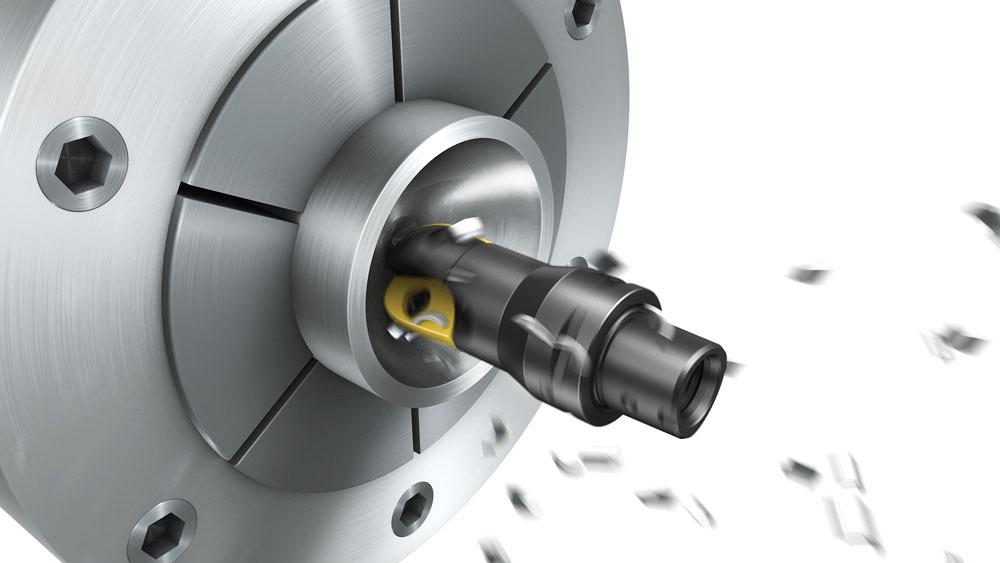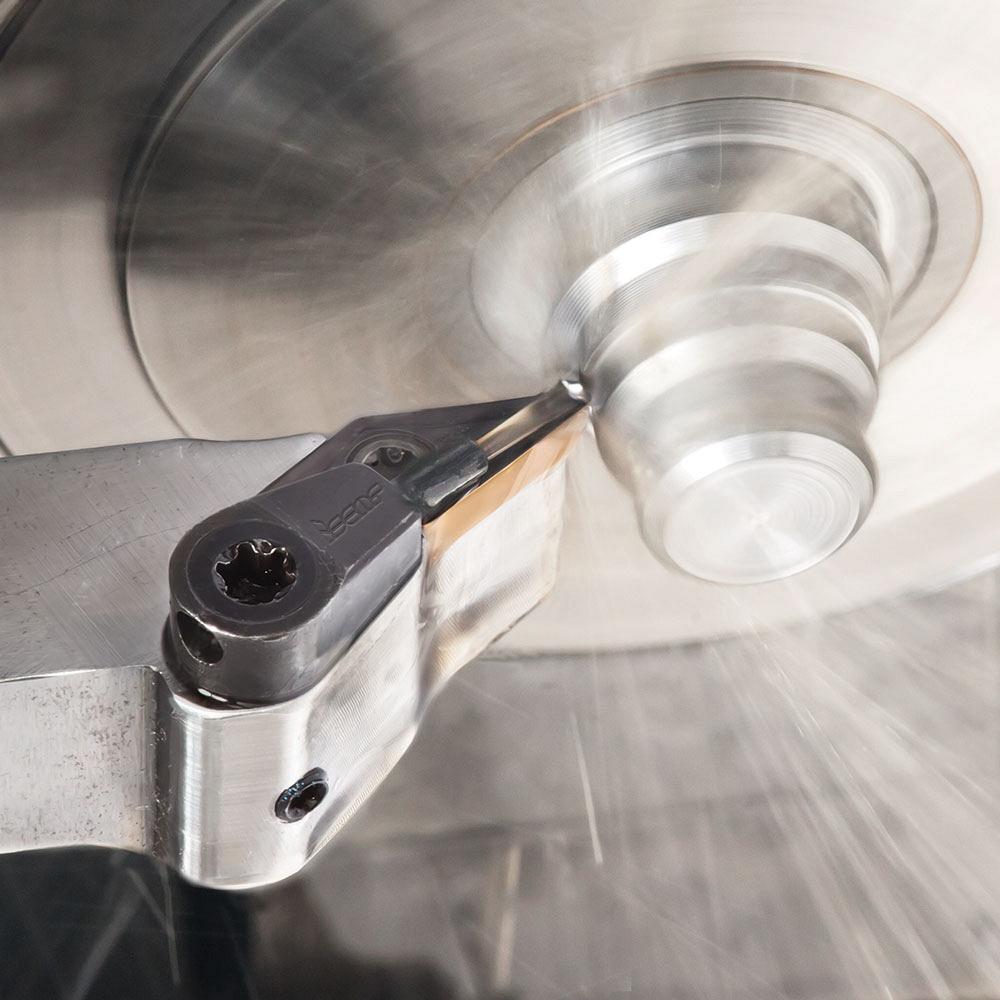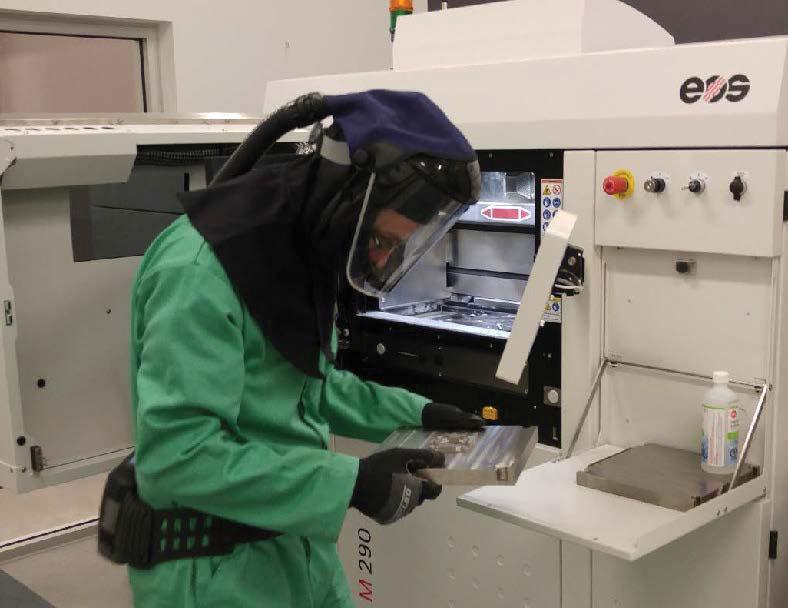- FMA
- The Fabricator
- FABTECH
- Canadian Metalworking
Medical Manufacturing Report
The future lies in joint replacements and … and maybe 3-D printing
- By Nate Hendley
- August 29, 2017
- Article
- Management

As the baby boom generation ages, medical parts such as hip joint cups are becoming a growing part of the manufacturing sector. Image courtesy of Sandvik Coromant Canada.
Want to see what the future of medical manufacturing might look like? Check out the hip cup. Made of titanium, this new product was designed and manufactured by Precision ADM (PADM), a fledgling Winnipeg firm primarily devoted to making medical and aerospace parts.
The hip cup is a hybrid part, according to Derek VanDenDriessche, director of sales and marketing at PADM.
The company used a Nakamura NTRX-300 multiaxis machining centre to machine the inner surface of the hip cup to ensure extreme smoothness. Much of the product, however, was 3-D printed on an EOS M 290 metal additive manufacturing machine.
At present, part production at the company is split roughly 50/50 between traditional machining and additive manufacturing, said VanDenDriessche. Other traditional equipment used at PADM includes Matsuura VX-1000 3-axis and MX-520 5-axis vertical machining centres and a GFMS CUT 30 P submerged wire EDM.
Precision ADM is a small, 12-employee company that was incorporated in May 2015 as a for-profit spinoff of the not-for-profit Orthopaedic Innovation Centre (OIC), also in Winnipeg.
Among other activities, the OIC tests medical devices, including hip and knee replacements. The centre generated headlines a few years ago by using 3-D printing technology to create a kneecap replacement for a dog.
Joint Replacement
The hip cup isn’t exactly a medical standard yet. In fact, it hasn’t actually been implanted in a human body (the company just received its ISO 13485 additive manufacturing certification for medical parts —the only AM company in Canada with such status, according to PADM).
The hip cup was designed and made in-house to show the company’s manufacturing capabilities, explained VanDenDriessche, who said design work is usually done in tandem with clients.
Beyond the fact that medical parts for hips, knees, elbows, and shoulders are a burgeoning field, it’s PADM’s vision that makes the hip cup a possible portend for the future.
“When most people think of 3-D printing, they automatically think of prototyping, and that really isn’t the case here. Our facility is set up for full-run production on these parts,” said VanDenDriessche.

Cylindrical medical parts can be manufactured using Swiss turn technology, which creates quick cycle times. Photo courtesy of Iscar Canada.
Traditional machine tools will still be necessary for finishing purposes, he added. That said, the concept of mass-producing medical parts with 3-D printers is an intriguing notion for a rapidly growing sector.
According to Health Canada, medical devices include such products as dental implants, diagnostic imaging tools, hearing aids, and orthopaedic products. The latter category includes joint replacements and constitutes 12 per cent of the global medical device market. As the huge demographic cohort known as the baby boom generation enters its senior years, it’s a safe bet that demand for joint replacements is only going to increase.
Between 2011 and 2016, exports of medical devices made in Canada increased to $3.1 billion from $1.8 billion, according to Innovation, Science and Economic Development Canada. Canada’s largest trading partner for medical devices is the U.S., with a total of $2.1 billion worth of medical devices being shipped from Canada to the U.S. in 2016.
Machine and cutting tool companies have plenty to offer medical part makers. Such companies are also making adjustments to come to terms with the rise of additive manufacturing.
Joe Wilker, multitasking product manager for Mazak Corp., said the two most popular machines he sells to the medical industry are the Integrex i-100 and Integrex i-150, both of which are efficient at producing small, complex parts in tough materials.
Mazak currently is developing a new machine tool in the Integrex line geared specifically toward medical manufacturing that it hopes will be released this fall.
One key aspect of medical manufacturing is the fit and finish, especially in surgical tools.
“The aesthetics of the part is extremely important. A nice finish and smooth blend; it has to feel right in the surgeon’s hands,” said Mike Finn, senior applications development engineer at Mazak.
The surface of medical parts has to be very smooth. Crevices, which can sometimes form in the area between two machined surfaces, must be avoided at all costs, said Finn. Bacteria can easily infest a crevice, causing infection or worse.
Cutting tool companies also have plenty of products for shops making medical parts.

Precision ADM (PADM) uses an EOS M 290 metal additive machine to 3-D print its hip cup orthopaedic part. It is then moved to the company’s Nakamura NTRX 300 to machine the inner surface of the part. Photos courtesy of PADM.
“Iscar specifically makes tooling to produce any kind of implant or any kind of part that’s going inside the human body,” said Steve Geisel, senior product manager at Iscar Canada. “All a customer has to do is show a drawing of what it is they have to make and we can come back to [them] very quickly with a full proposal.”
The proposal includes machine type, tools, inserts, estimated cycle time, and tool life.
Iscar even has developed illustrated images detailing medical parts and their respective components, plus tips on how to machine them. The image for a hip joint depicts a shell, liner, head, and stem, while the image for a knee joint depicts a femoral component, plastic spacer, and tibial component.
The Need for Speed
Proper machining of medical parts “requires the part to be spinning very, very fast,” said Geisel. To accomplish this, Geisel often recommends Swiss automatic machines because they’re going to have the quickest cycle time and produce the best-quality workpiece.
Kevin Burton, product and industry speciality for turning at Sandvik Coromant Canada, concurred on the need for speed in medical manufacturing.
“Obviously, speed is the biggest factor. You have to apply the correct speed,” said Burton.
Difficult-to-machine materials are the norm in the medical sector, with parts often being made from titanium, stainless steel, and cobalt chrome. This makes tool choice important.
“The geometry and grade [of the cutting tool] are specifically designed for those materials. Typically, in medical [part production] you’re looking at PVD grades for turning,” said Burton.
While Swiss automatic turning machines are suitable for parts such as bone screws and small, threaded cylindrical parts, more complex parts require more complex machinery.
“When you’re talking about more complex parts, like spine, hip, knee, ankle, and shoulder implants, and also instruments too, like endoscopes and drills, all that complex geometry can be machined complete on a [multitasking] machine,” said Finn.
Moving Into 3-D
Geisel described 3-D printing technology as fantastic for the medical industry.
“We are even using more 3-D printing ourselves. The technology is just going to improve. It’s definitely going to be the wave of the future, where people can essentially 3-D print a part pretty much near complete,” said Geisel.
Like VanDenDriessche, Geisel doesn’t see 3-D printing displacing traditional machining because there will always be a need for some machining work.
“Regardless of how good 3-D printing gets, you’re always going to have to do some sort of finishing operation,” he said.
Although Sandvik Coromant itself also has invested in 3-D printing, the company takes a traditional view of the use of such technology.
“We 3-D print prototypes ourselves. If it’s mass production, however, I don’t think it’s capable right now. It’s more for prototyping and one-off production,” said Burton.
For its part, Precision ADM wants to increase the amount of 3-D printing it does, according to VanDenDriessche. However, he admitted that shops looking to get into medical manufacturing likely will always require a blend of new additive and traditional subtractive equipment.
“If you just invest heavily in 3-D metal printers, you will be disappointed with the results of what you achieve, because you wouldn’t have the ability to complete the whole process,” said VanDenDriessche.
A good way for shops to prepare for creating medical parts comes from another sector: aerospace.
“There are a lot of similarities between aerospace machining and medical machining, and that’s because the materials being used for those products typically are exotic alloys like titanium, stainless steel, and cobalt chrome. So the tools used to cut these features have a lot of similarities,” said Finn.
Medical Manufacturing: The Future
So what is the overall prognosis for medical manufacturing? The sector is looking very healthy, and not just because baby boomers are greying.
“The medical industry is one of the fastest-growing industries because if you look at previous generations, people weren’t living as long. People were living into their 70s or 80s. Some of those people might need a [joint] replacement, but not many. Today you get these people living much, much longer, and because they’re living 20 to 30 years more, you’re seeing the requirement for medical implants and things like that increase. Therefore, for implants and medical parts, the demand is going to go up,” said Geisel.
Contributing writer Nate Hendley can be reached at nhendley@sympatico.ca.
Iscar Canada, 905-829-9000, www.iscar.ca
Mazak Corp., 859-342-1700, www.mazakusa.com
Precision ADM, 204-289-4491, www.precisionadm.com
Sandvik Coromant Canada, 905-826-8900, www.sandvik.coromant.com
About the Author
subscribe now


Keep up to date with the latest news, events, and technology for all things metal from our pair of monthly magazines written specifically for Canadian manufacturers!
Start Your Free Subscription- Industry Events
MME Winnipeg
- April 30, 2024
- Winnipeg, ON Canada
CTMA Economic Uncertainty: Helping You Navigate Windsor Seminar
- April 30, 2024
- Windsor, ON Canada
CTMA Economic Uncertainty: Helping You Navigate Kitchener Seminar
- May 2, 2024
- Kitchener, ON Canada
Automate 2024
- May 6 - 9, 2024
- Chicago, IL
ANCA Open House
- May 7 - 8, 2024
- Wixom, MI




















